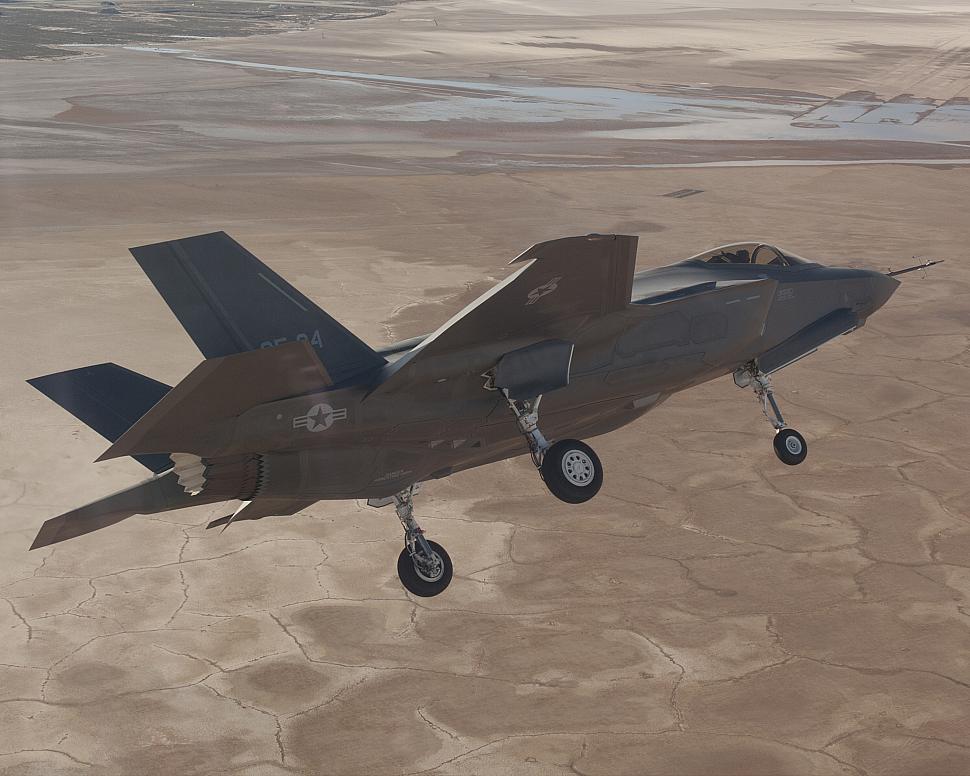Fighter Jet News
F-35 Lightning II News
Adjustments put F-35 on track
February 18, 2011 (by
Army Sgt. 1st Class Michael Carden) -
The Defense Department's joint strike fighter program is on track to field the Lockheed-Martin F-35 Lightning II in fiscal 2016, the program's director said February 15.

In remarks to the National Aeronautics Association, Navy Vice Adm. David Venlet said that although changes made to the program in January extended flight testing and slowed development by about a year at an additional cost of $4.6 billion, the program has made progress over the past year.
"We're not spending that amount of money in one year, but it's the added content across the years to (2016) that consume the $4.6 billion," Admiral Venlet said. "We have no doubts that achieving fairly high rates of production is obtainable, but it's going to take some discipline on the way."
The fiscal 2012 defense budget request submitted this week has little effect on the program, Admiral Venlet added.
"There's no change after (the Feb. 14 budget) announcement, and I believe I've got a very stable requirement," said Admiral Venlet, who has led the program since May. "We have not changed our inventory objectives."
Shaw Air Force Base is on the Air Force's list of the first six bases proposed to re-equip with the F-35. Further details will be in an environmental impact study the Air Force says it will release later this year.
The right plan is in place to ensure the program is efficient in terms of cost-savings and production, he added, noting that the program has undergone an intense technical review under his watch.
The latest restructuring, he said, was realistic, achievable and based on deep assessments of all aspects of the program.
"Previous plans had shortcomings, but this plan is very resilient," he said. "The plan has been able to overcome spotty parts shortages, engine delivery problems, (and) it absorbed snow days where weather shut down production in the Dallas-Fort Worth area."
Admiral Venlet said he has instituted more testing, increasing the number of hours and flights that test pilots fly, having recently increased the mandated number of test flights through fiscal 2016 from 5,800 to 7,700.
He's confident, he said, that the additional $4.6 billion will hold up, as development and testing concludes in 2016.
Competition for the F-35 contract began in 1996. The $200 billion contract was awarded to Lockheed-Martin in October 2001, and the program immediately went into a 10-year testing and development phase.
Defense Department officials plan to purchase 325 aircraft through 2016, and the overall program consists of 2,443 total aircraft in three different variations. The variations include a takeoff and landing variant for the Air Force, an aircraft carrier-suitable version for the Navy and short takeoff and vertical landing variant for the Marine Corps.

The fifth flight of AF-04 seen as it arrives overhead at Edwards AFB on January 22nd, 2011 after a 3.2-hour ferry flight from Fort Worth, Texas at the hands of Maj. Matt Hayden. The aircraft is the fifth F-35A conventional take-off and landing aircraft to ferry to Edwards for testing. [Lockheed Martin photo by Liz Kaszynski]
"We're not spending that amount of money in one year, but it's the added content across the years to (2016) that consume the $4.6 billion," Admiral Venlet said. "We have no doubts that achieving fairly high rates of production is obtainable, but it's going to take some discipline on the way."
The fiscal 2012 defense budget request submitted this week has little effect on the program, Admiral Venlet added.
"There's no change after (the Feb. 14 budget) announcement, and I believe I've got a very stable requirement," said Admiral Venlet, who has led the program since May. "We have not changed our inventory objectives."
Shaw Air Force Base is on the Air Force's list of the first six bases proposed to re-equip with the F-35. Further details will be in an environmental impact study the Air Force says it will release later this year.
The right plan is in place to ensure the program is efficient in terms of cost-savings and production, he added, noting that the program has undergone an intense technical review under his watch.
The latest restructuring, he said, was realistic, achievable and based on deep assessments of all aspects of the program.
"Previous plans had shortcomings, but this plan is very resilient," he said. "The plan has been able to overcome spotty parts shortages, engine delivery problems, (and) it absorbed snow days where weather shut down production in the Dallas-Fort Worth area."
Admiral Venlet said he has instituted more testing, increasing the number of hours and flights that test pilots fly, having recently increased the mandated number of test flights through fiscal 2016 from 5,800 to 7,700.
He's confident, he said, that the additional $4.6 billion will hold up, as development and testing concludes in 2016.
Competition for the F-35 contract began in 1996. The $200 billion contract was awarded to Lockheed-Martin in October 2001, and the program immediately went into a 10-year testing and development phase.
Defense Department officials plan to purchase 325 aircraft through 2016, and the overall program consists of 2,443 total aircraft in three different variations. The variations include a takeoff and landing variant for the Air Force, an aircraft carrier-suitable version for the Navy and short takeoff and vertical landing variant for the Marine Corps.
Courtesy of American Forces Press Service
Related articles:
Forum discussion:
Tags
- $3.5 Billion contract awarded For 4th lot of F-35s ( 2010-11-19)
- Norway reschedules F-35 buy ( 2010-09-28)
- Marines move forward with F-35B ( 2010-03-19)
- F-35 Lightning II news archive
Forum discussion:
- Start a discussion about this article in the F-35 forum.
Tags
